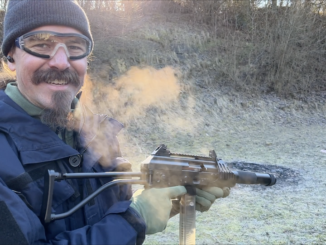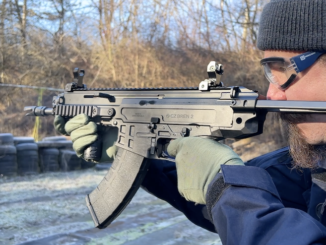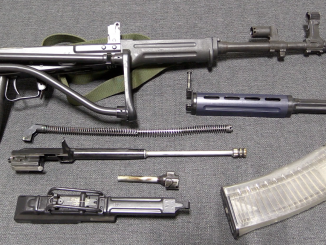https://www.instagram.com/czguns/
https://www.facebook.com/CZfirearms
Yesterday we looked at the development of the Skorpion PDW/SMG in 9x19mm Parabellum both in the 1960s and then when it was revisited in the 1990s at CZ. Today I have the chance to take one of the 1990s Skorpion 9×19 models out the the range for some firing. I was expecting it to be a fairly violent gun, but much to my surprise it was quite controllable and soft shooting. The rate reducer does a very effective job of holding down the rate of fire, and that help control the potential of significant climb while firing. In addition, the stock was lengthened about an inch to match the lengthened 9×19 receiver, and that extra length is enough to make a big impact on comfortably shouldering the gun. It was quite a pleasure to shoot! Ultimately, its commercial failure was not the result of handling problems, but rather complexity and cost.




On the hour somewhere at the end, judging by the church bells.
Sometimes, when you want to build something to fulfill a stupid requirement (full-auto in a pistol-sized package…) the things you have to do in order to make it work are insanely expensive and entirely impractical.
Physics being physics, I suspect that we’re never going to see a truly effective PDW (in terms of being able to substitute for the lower end of the carbine class) in a pistol-sized package that can be built affordably for mass-issue. At least, not until we’re extruding finished working weapons out of 3D print platens…
I’ve often wondered how you could get around all the issues, and I just don’t see a way of doing it, unless you figure out how to pack something like a Gyrojet motor package into a soft-launch system that would afford you the ability to actually fire it and control the damn thing; and, by then? We’ll probably have guided projectiles that will totally obviate the need for full-auto fire.
Of course, we’ll also likely have countermeasures, sooooo… Who the hell knows where we’ll be, in a hundred or more years?
“(…)how you could get around all the issues, and I just don’t see a way of doing it, unless you figure out how to pack something like a Gyrojet motor package into a soft-launch system that would afford you the ability to actually fire it and control the damn thing(…)”
If you do not need specifically 9×19 then consider using small-bore caliber akin to “carbine class” e.g. 5.56×29
https://modernfirearms.net/en/submachine-guns/u-s-a-submachine-guns/colt-scamp-eng/
or 6.5×25 CBJ-MS
https://modernfirearms.net/en/submachine-guns/sweden-submachine-guns/cbj-ms-pdw-eng/
The problem there is velocity, or rather the lack of it. To achieve enough KE to make it viable, the MV of a small (5-6mm) lightweight (1.5 gm or so) bullet has to be up around 800 m/s. That’s very difficult to do in what is basically a pistol-length barrel.
The 5.7 x 28mm is a case in point. MV from the FN P90 PDW is around 750 m/s and energy is almost exactly that of 9 x 19mm NATO (~500j).
Out of the much shorter barrel of the FiveSeven pistol, MV drops to 450m/s, or about that of the .22 WMR from a pistol, yielding about 200j. Or in historical terms the ME of the old 0.380in British Service revolver aka .38 S&W (not “Special”, the one introduced in 1877).
In his SF story “The Last Enemy” (1956) H. Beam Piper postulated ultra-small caliber (about 4mm) pistol rounds with MVs of over 3,000 m/s. The solid projectiles absolutely did not expand, but a single hit in the torso tended to puree’ its contents.
In 1974, Col. Jeff Cooper postulated a “very small, very hard, very sharp-nosed” projectile with an MV of “around Mach 4” (~1400 m/s) which in his words could “burn through any reasonable level of body armor and yet deliver decisive power beyond it”. It was Piper’s concept taken one step further, almost to the level of becoming a dedicates CQB arm due to atmospheric friction’s effects on the projectile at ranges much over 50m.
Exactly how to get there remains the problem. I suspect the near-term answer would be a liquid propellant, as even the few viable ones from liquid rocket motor research going back to the 1950s have much higher energy (kCal) per mole than the most advanced propellant powders of today, and also outdo such things as the modified HE used in caseless ammunition like the H&K 4.7mm in the G11 rifle.
Beyond that, you’re probably going to need some form of electromagnetic system, a “coil gun”, “rail gun”, or “mass driver”. With advances in electronics such as high-temperature superconductors, that might even be a more practical line of development, although “barrel” length would likely leave it in the “rifle” as opposed to “pistol/PDW” category.
However you get there, always remember that the first rule of small arms power is the same as the first rule of highway safety.
Speed Kills.
cheers
eon
Elder Keith related how he lathe-turned welding rod to make .17 caliber bulletc he then loaded to 3000 fps. He claims the projectiles simply went through jack-rabbits who didn’t even notice till they bed out. I take the story with a grain of salt. Still the claim velocity as such kills is over-optimistic. Energy has to be transferred to the target and a tiny projectile works under limitations. Whether things improve at Mach 3 is an open question.
Surprisingly easy to shoot and lot lighter than say UZI.
“(…)lighter(…)”
Surprisingly for me http://www.vhu.cz/exhibit/samopal-cz-skorpion-9-x-19/ does weight 2240 g (with empty magazine) which make it lighter than Ingram M10 (also 1960s design) https://modernfirearms.net/en/submachine-guns/u-s-a-submachine-guns/ingram-mac-10-m10-m11-eng/ weighting 2,84 kg empty.
“(…)UZI”
Well, UZI was one of early (first?) design by Uziel Gal, whilst said weapon was one of later (last?) design by Miroslav Rybář. Former later designed Ruger MP9 http://modernfirearms.net/en/submachine-guns/u-s-a-submachine-guns/ruger-mp9-eng/ which which weights 3 kg, which is less than original UZI is still heavier than CZ SKORPION 9 x 19
Ppsh shoot them in the nuts.
This is not how dwellers of Czechoslovakia designed their fire-arms. For example of 7,62×25 mm “classic” (wooden furniture, magazine well in front) sub-machine gun see CZ 347 https://modernfirearms.net/en/submachine-guns/czech-republic-submachine-guns/cz-247-eng/
CZ should get the patent rights for their products as soon as possible. Otherwise it will not end well. Here is an article in Turkish on this subject.
https://silahalsat.com/silahalsat-blog/cz-75-en-cok-kopyasi-yapilan-tabanca/35